Customer service could make all the difference between your shop and the one down the road.
by Eli Greenbaum
Why does one collision centre thrive with a sterling reputation while the one across the street struggles to acquire and retain customers? There could be a lot of reasons: the quality of the work, pricing, marketing, or maybe the successful shop has a commitment to delivering outstanding customer service while the other shop does not pay much attention to that aspect of the business.
But why would a shop not pay attention to customer service? The customer is the most important part of a business. Without customers, there is no business. It is as simple as that. So it makes sense that if a business wants to succeed, it should make customer service a priority.
Customer service is the support a business offers its customers when they use its products or services; it is intended to give customers an easy and satisfying experience—the kind of experience that instills loyalty. Think about your own experiences with retailers, service providers, or any other business entity you have dealt with. Which ones do you return to? And which ones do you recommend to friends and family?
With collision repairs, it is not just about fixing the vehicle. A smooth repair done right and on time is now the norm; it is the minimal expectation. Today, however, it is all about the total customer experience and managing it properly. Customer service is critical to competing effectively.
The Stages of Customer Service
In the collision repair industry, there are three key stages of customer service: 1) initial contact or intake, 2) the repair period, and 3) post-repair. Consider the initial contact: These days customers will contact your collision centre by phone, email, or in person. How quickly and professionally you respond matters. Recently, I emailed three shops to arrange an estimate appointment. One shop responded within 30 minutes. Another shop responded the next day. One shop did not respond at all. Who do you think got my attention?
Many people opt to call the shop. If the shop answers within three rings, that is good. More than three? Sorry, too long. There are plenty of other shops that will answer quickly. And then there are the walk-in customers; that is where the appearance of your facility and staff can make a difference. Is the building neat with clear signage, adequate parking, and easy access? Is the reception area clean and inviting? Are employees courteous, knowledgeable, and properly trained to address the customer and review the damage to the vehicle? A yes response to each of these questions is a good start. But there is more to consider.
“It is all about the total customer experience and managing it properly.”
The first meeting with a customer is your opportunity to turn that individual and everyone he or she knows into future customers; it is an opportunity to make a positive impression and a valuable connection. The customer wants a vehicle repaired, wants it babied, wants it to come out of the shop looking and driving like new. If he or she is not confident you can deliver, that other shop down the street may get the business. And if the customer comes to you as the result of an insurance-designated DRP, do not relax and assume you have it made. That customer could have been directed to your shop, but could be unimpressed by what he or she sees and could easily go elsewhere. Furthermore, they could report a negative experience to the insurer, resulting in loss of future referrals.
The moment the customer makes contact is your moment to shine. Make that customer feel important. Display empathy for their situation. Ask about how the damage occurred. Acknowledge the inconvenience. And most important, clearly explain the repair process. This is a critical step: detail the process in plain words—no technical terminology, hype, or far-fetched promises (no “We’ll have the car back to you in two weeks” when you know it may take that long just to get the parts) that lead to under-delivering and unhappy customers. Make sure you have asked the customer how frequently and by what means he or she wants to be kept informed—text, email, or phone? By being truthful and clear with the customer, you can present a process that will provide realistic expectations that you can manage and most customers can accept.
During the fix is no time to relax. While the car or truck is in your care, customers are thinking about their vehicle and wondering when they will see it again. This is when it is imperative to keep a customer informed about the status of their vehicle’s repairs. At this point the customer has told you how they want to be kept informed; it is your responsibility to do so. Keep communicating. Explain the repair status, what has been done, what needs to be done, and the reason for delays or schedule changes, if any; answer questions directly and honestly.
Once the repairs have been completed and the vehicle is ready for delivery, give the customer as much notice as possible so he or she can make arrangements for pickup, and make sure there are no glitches in the delivery process. If you said Friday afternoon at three, four is not acceptable. Have the vehicle ready to go: clean, washed, and looking great. This is when customers will see the vehicle and decide if your shop has done the quality job they expected. And this is when the customer goes home and possibly writes a review on social media. Chances are pretty good that if you did not do a great job all the way around, the Internet world will know about it. One way to help yourself is to provide your customer with a post-repair survey. That shows you care about what the customer thinks. What you learn will let you know how you are doing and what changes, if any, you may need to make.
Looking Deeper
To learn more about this topic and to see what collision centres should be doing to support their customers, I spoke with Laurie Brown, owner of Laurie Brown Communications. Brown is a business consultant with an expertise in customer service. She has worked with clients in the Middle East, Asia, Latin America, Europe, Australia, and throughout the United States and Canada helping them improve customer service delivery. She has consulted with diverse groups at all corporate levels; her clients range from Fortune 500 companies and government agencies to smaller family-owned businesses.
In our conversation, Brown immediately made one major point: “Great service needs great communication,” she said. “If a customer has to call and ask, ‘Is my car ready?’ then you have already failed. Communication is key. It’s always better to overcommunicate than to undercommunicate.”
Part of that focus on communication includes managing expectations. “Don’t be afraid to make promises, but make them promises you can keep,” she added. “For example, you don’t have to give a finish date because that can be an unknown; however, you can promise to call and provide updates and follow through. Is there a parts problem? Is a painter out sick? Will that affect the repair schedule? Don’t wait. Make the call. Keep the customer informed.”
Brown pointed out that in her experience there are two basic types of customers: the “no news is good news” and “no news is bad news” types. “The good news customers don’t want to be bothered until the car is ready—but you better call them when it is, and if you promised a status update date, contact them then. The bad news customers that need hand-holding want to be contacted more frequently. In both cases, make sure you do as you promised. Ideally, a customer should never have to call for a status update.”
Brown recently had her own car in for collision repairs. While it was in the shop, she could go to the collision centre’s website to check on her car’s status and see photos of what was being done. Obviously, this can be an expensive option for a shop, but it does free personnel to do other work and allows the customer access as desired.
“Great service needs great communication, if a customer has to call and ask, ‘Is my car ready?’ then you have already failed.”
Brown pointed out that a customer just wants to be treated well. Yet customer service is never one-size-fits-all. A shop rep must take cues from the customer about how he or she wants to be treated. Communication can help find that sweet spot simply with a little conversation and some follow-up. That will allow for service customization and the opportunity for a shop to make an impression.
“It’s important to make customers feel special,” said Brown. “Little things can mean a lot. When they pick up the car, give them a bottle of touch-up paint. Does the customer have a dog? Have a bag of treats ready. Going to a sporting event? Wish their team good luck. They’re all small gestures that stand out.”
Brown summed it up by saying, “You—the person at the front desk—are the face of the shop. Everything you do represents the shop. I’m the customer, and I’m thinking if the front desk is messy, if the staff is not well groomed, if the place is dirty, how can I trust you with my car? If you can’t take care of yourself or your facility, how will you treat my car? Everything matters. Customers give reviews: when they’re angry, they want the world to know how bad your shop is. Conversely, when they’re delighted, they’ll sing your praises to the rafters. You always want the latter. Bottom line: Overcommunicate. Personalize. Under-promise and over-deliver. You’ll be a hero.”
How Some Shops Are Doing It
How does Brown’s advice translate to on-the-job customer service? I checked with a few companies in the automotive collision and repair industry to see how they do it.
Murphy Tarves is the director of business development at the Craftsman Group. Based in North Vancouver in British Columbia, this family-owned and operated company is Canada’s largest MSO with 43 collision centres across Saskatchewan, Alberta, and British Columbia.
Tarves understands how important it is for the Craftsman Group to be recognized as a customer service-oriented organization. Formal customer service training has been in place for more than 10 years and is refined on an ongoing basis. An onboarding program is mandatory for all new hires. They work closely with members of the company’s support centre team to make certain they are properly trained in all customer service protocols for every step of the repair process. According to Tarves this ensures they have a complete training experience that gives them the tools, skills, and confidence required for their hired position.
“We see customer relationships as opportunities, so we put a heavy emphasis on training,” Tarves said. “We want to start our new hires running, and as a result of training we are able to provide a consistent customer-focused approach across all our shops.”
“We are active listeners from start to finish,” Tarves added. “We spend more time with the customer up front, give them communications options, and manage expectations. We keep the customer informed in line with their preference. In fact, we have a unique software program that tracks customer communications to ensure the right information is reaching them.”

In addition, Craftsman Group facilities are designed to be warm and inviting place for customers to wait, but they plan estimate appointments and vehicle deliveries so that customers rarely need to wait. “We want our customers to focus on the quality of our work and service so we pay attention to details, schedules and the promises we make,” Tarves said. “We want to make it easy for them. We have more than 500 replacement vehicles across our locations available for customers to use during their repairs. We provide a valet service as well. We know how important our customers are.”
The management and employees of the Edmonton-based Go Auto organization also understand the significance of customer service. “It’s a top priority” said Jennifer Manchur, the company’s manager of bodyshop operations in Alberta. “Our entire company—collision centres and car dealerships—is geared toward customer service. We have more than 40 locations in Canada. Our core values include being trustworthy team players that are happy to help. That translates to excellent customer service across the board.”
Go Auto employees attend Go University which is located at the company’s head office in Edmonton. This is where they learn Go Auto’s values and its cultural emphasis on customer service in a special class known as Customer Service 101. “All our employees take New Staff Orientation/Customer Service 101,” said Manchur. “We want everyone on our staff to be able to relate to our customers and work with them. We want to meet our customers’ expectations and treat them fairly. This means our whole organization has to make a commitment to service.”
Employees are taught to listen to the customers, be honest with them, and not mislead them about any aspect of the entire repair process. In the unlikely event that something does not go according to plan, Manchur does all she can to make things right: “Once in a great while something unexpected may happen—a car is scratched as it is being prepped for delivery, for example. We certainly can’t turn it over to the customer in that condition, so we do our best to make up for such a mishap. Beyond expertly fixing the scratch, we’ll provide the customer with a discount on future services, or provide a loaner car, or do something to acknowledge our error and their importance to us. We know unhappy customers will go elsewhere; we don’t want anyone leaving unhappy.”
A customer-focused orientation is increasingly evident at collision centres and dealerships across the country. At Docksteader Subaru in Vancouver, for example, service advisor Delson Tsang and his colleagues take online and in-person classes in customer service and product updates on a quarterly basis. They must earn customer service recertification annually. “Our job is to make sure the customer is properly served,” he said. “Our goal is to exceed their expectations.”
MSOs, dealerships, and large independent shops are big operations with formal customer service training procedures in place. But smaller collision centres and automotive repair shops also recognize the importance of customers and the service they expect. Ben Main owns Ootmar Automotive in Vancouver. It is a mechanical repair shop that works directly with the public to maintain and repair vehicles and on occasion helps collision centres in the area. Main started working at Ootmar in 1990, and in 2016 he bought the shop from the previous owner. Main has a simple and effective approach to customer service: “I treat the customer the way I would like to be treated,” he said. “I put myself in the customer’s shoes and follow the golden rule.”
Apparently, it works. Main has a remarkable 80% repeat customer rate—eight of ten new customers come back. What accounts for such a high rate of customer satisfaction and loyalty? “I ask a lot of questions up front,” he said. “I find out what the customer expects, the best way to contact them during the work, I give fair estimates, and I stick to what I promise. If we make a mistake, it comes out of my pocket, not the customer’s.” He follows up with new customers to make sure all went well and that they are satisfied.
Main made an impressive point: when a new customer calls for an estimate about mechanical work, Main will ask, “Do you want the cheapest price or do you want the best value?” That opens up a conversation about customer expectations, the parts that will be used, the warranties involved, and the comfort a customer experiences when the repairs are done right.
Great Customer Service Makes a Difference
Ben Main summed it up perfectly: Treat the customer with respect. Listen. Empathize. Be clear and truthful in communications and keep the customer informed. When the repairs are made and the vehicle delivered, follow up with the customer and learn from the feedback.
Collision centres today cannot afford to ignore customer service. Poor customer service eventually shows up on the bottom line. The industry is highly competitive and one false move that turns into a negative customer experience can prove costly—especially when that negative experience is reported on a social media platform as part of a review or becomes a story at the office water cooler or among friends. Word of mouth can work for you or against you. There was a time when people chose a shop on the basis of price or delivery date promised—which almost always changed, but that is not necessarily the case anymore. Aside from ensuring that repair work is top quality, sharp business owners or managers must also consider what customers experience when they do business with their shop. Good experiences lead to good customer relationships, which can lead to more customers. In the end, think of great customer service as an effective marketing and advertising tool: because that is exactly what it is.





